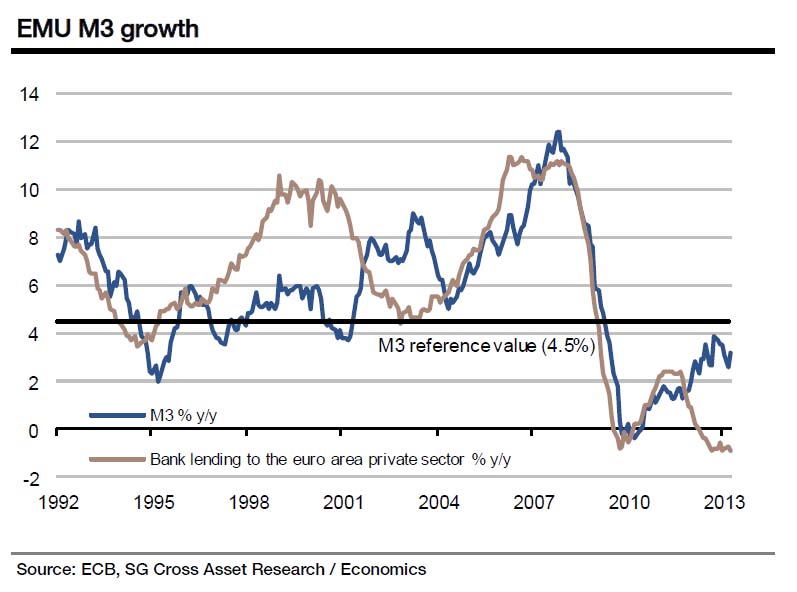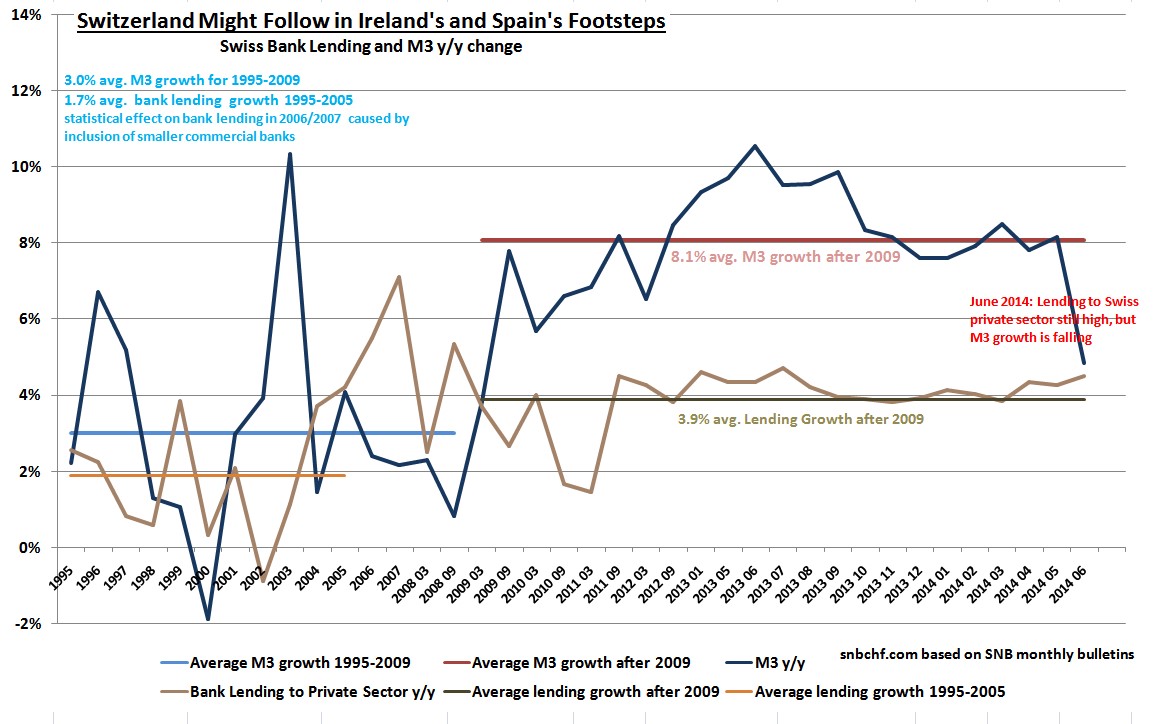Since the financial crisis central banks in developed nations increased their balance sheets. The leading one was the American Federal Reserve that increased the monetary base (“narrow money”), followed by the Bank of Japan and recently the ECB. Only partially the extension of narrow money had an effect on banks’ money supply, so called “broad money”. For the Swiss, however, the rising money supply concerns both narrow and broad money. Broad money in Switzerland rises as strong as it did in Spain or Ireland before the financial crisis.
The Monetary Base

M0, central bank money or monetary base (MB) are sight deposits of domestic banks at the central bank plus the bank notes. In 2012, the total amount of Swiss bank notes increased quite slowly, as opposed to exploding sight deposits.
Is more and more “money” dangerous?
![]() This is the ordinary theory:
This is the ordinary theory:
If a central bank prints more money, then domestic banks have more funds available to give loans and mortgages. Via the money multiplier they are able to generate far more money than the central bank actually provides with M0.
This is the old text book approach. Nowadays things are different in Western economies. There were the times when banks were “fully loaned up”, meaning that they hit the limit of minimum reserve requirements, something which the case still today in China or other Emerging markets.
Nowadays things are a bit different in Western countries: Via quantitative easing central banks of QE countries purchase back their own government bonds from insurances or pension funds, so that those investors convert these holdings in more risky assets. Since investments are global in our day, the effect spills over into (risky) assets in Emerging Markets (EM). The consequence is that investments and wages in EM rise excessively and the currency of a QE country depreciates. This is positive for the QE countries because it reduces their competitiveness gap. Thanks to the closing of the competitiveness gap it has helped U.S. home prices, since 2013 U.S. manufacturing to recover.
The QE effect also spills over into nations like Switzerland and helps to push up Swiss asset prices and the Swiss franc. The SNB had the choice between a stronger currency and, secondly, an excessive appreciation of the Swiss assets. With the introduction of the euro floor, it opted for the second alternative and increased its monetary base massively in order to absorb foreign currency inflows. Implicitly the central bank helped to push up asset prices even further.
Hence it was rather foreign demand for Swiss assets that helped to increase the demand for credit and money in the real economy. And the final answer is: Yes, more and more money is dangerous.
The first risk: Swiss broad money supply rises like it did in Spain or Ireland before
Countries like the US, Spain, the UK or Ireland saw monetary aggregates rise quickly between 1999 and 2007, below the broad money aggregate M3. The European monetary union saw increases of 8% per year, but nominal GDP growth was around 5%.
The following graphs show, that credit to Swiss private borrowers rose in line with nominal GDP growth between 1994 and 2007. When both growth variables rise with the same pace, then the growth is considered healthy (especially by monetarists and Austrian economists).
The SNB printed a lot of money especially in the years before and just after the euro introduction until 2003, to weaken the franc and the “presumed slow” Swiss growth. The money increase, however, did not affect credit growth more than it should have: investors preferred other countries to Switzerland to buy assets. Finally the central bank increased interest rates a bit and reduced money supply between 2006 and 2008. Be aware that in 2006/2007 there is a statistical effect with the inclusion of “Raiffeisen” group banks into M3.
Since 2009, things have changed M3 is rising with an average of 7.7% per year., while before 2009 it was 3% per year. Banking lending to the private sector is increasing by 3.9% per year while it was 1.7% between 1995 and 2005.
Some say that the reason for more loans and mortgages were the bilateral agreements between Switzerland and the EU that allowed for more immigration into Switzerland. But these agreements date from 2004 and the effect would have shown up already before.
The SNB is fully aware of the risks. SNB’s Danthine shows the sharp increase of the credit to GDP ratio in several countries (source). For him the reasons were:
- Improved credit access due to structural reduction of supply side constraints (financial liberalization, innovation)
- Structural increase in credit demand (e.g. growth opportunities, cultural changes or demographic shift)
- Extended period of low interest rate
- Overconfidence and misjudgement of borrowers and/or lenders (behavioural biases)

source SNB
The second risk: cheap Swiss money lending to foreign
Since April 2014, money supply M3 has suddenly stopped at around 940 billion CHF. Before it had increased by 80 bln. CHF per year from 626 bln. in each year since 2008. We explained before that Fed’s QE translated in higher lending in dollars, dollars that found their way into emerging markets. The same thing happens in Switzerland with newly created Swiss francs. Not all of them remained in the Swiss economy, but they were loaned out to clients from Emerging Markets.
Hence the second risk does not directly concerns the Swiss economy and the euro, but the relationship between its banks and emerging markets and the risks of a strong franc for banks’ balance sheets.
From the Wallstreet Journal on Credit Suisse:
Much of this new money is from Asia and other emerging markets. One of the things attracting these clients is Credit Suisse’s willingness to make large loans to the ultrawealthy. Such loans have grown by CHF3.9 billion over the first nine months of this year versus CHF1 billion in the same part of 2013. They are often backed by the borrower’s illiquid wealth in the form of equity in their companies, for example, or warrants for future ownership.
Such lending can be hugely profitable. Yet any investor who has seen more than one cycle in countries such as Indonesia knows it can also be quite risky. (source WSJ)
Disclaimer: The opinions expressed above are not intended to be taken as investment advice. It is to be taken as opinion only and we encourage you to complete your own due diligence when making an investment decision. Even if we often write about Forex trading, our advices aren't written for day traders who follow technical channels, but rather for mid- and long-term investors. Our aim is to show discrepancies between fundamental data and current asset valuations, which can lead in mid-term to an inversion to technical channels.


